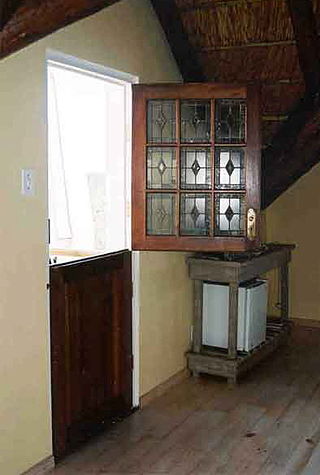Dutch door
Type of door From Wikipedia, the free encyclopedia
A Dutch door (American English), stable door (British English), or half door (Hiberno-English) is a door divided in such a fashion that the bottom half may remain shut while the top half opens. They were known in early New England as double-hung doors.[citation needed] The initial purpose of this door design was to keep animals out of farmhouses or to keep children inside while allowing light and air to filter through the open top, essentially combining a door with a fairly large window. When the top half was open, they also allowed a breeze, but stopped the wind from blowing dirt into the house.



Uses
Summarize
Perspective
This type of door was common in the Netherlands in the 17th century and appears in Dutch paintings of the period. They were also commonly found in the culturally-Dutch areas of New York and New Jersey before the American Revolution.[1]
Dutch doors were often incorporated into the design of passenger railcars in North America to allow crewmen to interact with employees outside or to carry out visual inspections. In Australia, post-war passenger cars and brakevans were similarly configured. However, those on passenger cars were later converted to conventional doors for passenger safety reasons. In Canada, changes to operating rules[ambiguous] rendered the Dutch doors obsolete, although older rolling stock retains them.[citation needed]
Similar doors were once commonplace in Irish houses, called half-doors (Irish: leathdoras or comhla bheag).[2] According to The Irish Times, "A traditional half-door is really a door and a half – a full door that opens inwards and a half door set to the front of the frame that opens outwards." They were designed to keep poultry and pigs from entering the house, as well as allowing air and sunlight into the usually dark and smoky cottages.[3][4][5][6][7]
They have been used internally in residential care homes to control wandering but maintain a line of sight[8] and in child-care environments, but in that context, there are risks of finger-trapping and concerns over fire regulations.[9]
See also
A Lev door is another type of split leaf door, in floor-to-ceiling configuration, with a standard size leaf and a disconnected additional leaf installed in the space above it, which enables the unrestricted passage of heated air along the ceiling from central source, improves cross ventilation, and maintains privacy.
References
Wikiwand - on
Seamless Wikipedia browsing. On steroids.
